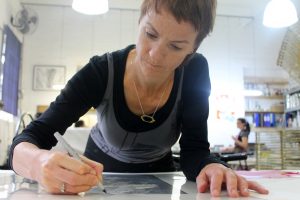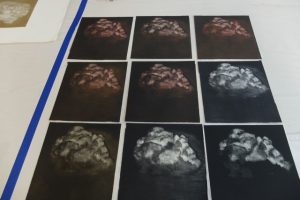Robyn Penn has collaborated with David Krut Projects on multiple shows and prints, and the workshop team has been hard at work alongside Robyn again, on a new project entitled Nine Views of a Cloud.

The series consists of clouds in a variation of colours in a small scale Image size(Image Size 19.5 x 21.5 cm – Plate size – 20 x 21.5cm.) A total of nine prints created on two individual plates printed in a variation of nine colours.A beautiful and resting aesthetic reminiscent of the Romantics within a contemporary era.
Robyn Penn, Nine views of a cloud, 2015 (work in progress)
We sat with Robyn to better understand the concept and process behind the new works.
DKP: Could you please explain the concept behind Nine Views of a Cloud?
RP: I suggested to Jillian Ross, master printmaker, some time ago that I would like to make a series of mezzotints. I love the slow, laborious process involved in ‘rocking’ a copper plate to a velvety black and then gradually, meticulously coax out an image from the shadows. This process and that of oil painting seem to be in direct conflict with my subject matter, a fleeting cloud, and also an absolutely appropriate response to the enormity of nature and the inadequacy of one’s sensibility and imagination to fully grasp it. The reference for the series of mezzotints is a solitary, highveld cumulonimbus I photographed in a clear blue sky. This cloud is also the subject of other works currently being made in my studio. The process of drawing and re-drawing an image has long been an obsession of mine. The title of this body of work references the Ukiyo-e practice of revisiting the same view.
Some of the more famous landscape images made by Ukiyo-e artists Hokusai and Hiroshige were made in series. Such as “Views Along the River Banks of the Sumisa River”, “The Fifty-Three Stages Along the Tokaido” and “Thirty-Six Views of Fuji” (all by Hokusai).
The cross pollination between east and west is particularly interesting in these works. The woodcut art of the Edo period was not concerned with landscape painting, but rather with portraiture and urban scenes, until Hokusai and Hiroshige started making their large series of landscape works influenced by western art. Their prints portrayed the glory of nature in the Japanese landscape. Rendering shadows and introducing tricks of perspective they had seen in French and Dutch copper etchings. The art at the time filtering from the east to the west, caused the modernists to abandon traditional tricks of perspective and brighten their palette.There is a resonance for me here in how print influenced my painting and then my painting practice is informing the way I work in print media.
DKP: The series has a variation in colour. Could you explain your colour palette choices?
RP: I used combinations of blacks, blues, gold and red. The colours form a sort of colour chart rather than a realistic representation of the sky.
DKP: How was scale decided for this series and how does it contribute to the final image?
RP: Each individual print is quite small – 200mm x 220mm. It seemed a good scale to start working on for mezzotints since they are labour-intensive and time-consuming to make. The final work, in a tight grid, is 600mm x 660mm. The scale makes the work intimate and draws the viewer in, but also has a presence.
DKP: How would you best display the works once complete?
RP: The series of Nine Views of a Cloud are intended to be grouped together. They lend themselves to being displayed in various groupings. They can be grouped in a tight grid or scattered across a wall for example.
DKP: How long have the works been in process?
RP: About a year, I think…
DKP: You have been working with Jillian Ross on the new prints; how do you find the work process with her as a guide in both concept and technique?
RP: Jill and I have a great working relationship. I have a lot of respect for her and her team. Jill is like an alchemist guiding me in transmuting my elusive ideas into forms on copper. She manages to always make insightful suggestions, she knows when to push me into experimenting with unknowns and also when to stand back and let me find my own way in making an image.
DKP: The concept of clouds, as a visual, is present in most of your works. Could you tell us where the inspiration/influence is drawn from?
RP: I find clouds and the sky sublime, a reminder of the transience of the moment, and in the spirit of Caspar Friedrich and the Romantics, a reminder of the awesome force of nature. Clouds are ever-present, ever-changing forms and as such lend themselves to my immersion in the natural processes of transformation and dissolution.
DKP: What is your expectation of the viewer once your work is exhibited?
RP: Hopefully they like the work!
DKP: How would you describe the environment at DKW?
RP: There is a great energy in the workshop. There is always a lot happening, a collaborative spirit of learning and sharing skills.
DKP: What are the technical complexities you are beginning to understand about printmaking?
RP: So much! Etching is new to me and we are working with several processes: drypoint, hard ground, sugar lifts, aquatints, mezzotints. It is very technical and I have to keep all the processes and their possibilities in my head. But I feel I can experiment and be playful. I find it an engaging, challenging and exciting process.
DKP: Can you describe printmaking and its influence on you as an artist, and why it continues to have timeless relevance?
RP: One of the main influences in my painting is the work of Japanese printmakers. It is a wonderful thing to have been looking at prints for so long and making paintings, and then approaching making a print with the hand and eye of a painter.For me working on etchings is almost like working in reverse. I have an idea of the image I want to make and have to separate it into various layers that I make on separate sheets of copper and then print the finished etchings on top of one another. There is magic to printmaking. It is not predictable and that wonderful element of chance in something so well planned is alluring.
